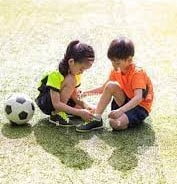So, diving into the coed soccer debate sparked by Marc and Denise, it’s clear there are different viewpoints at play. Marc’s concern about girls feeling sidelined by more dominant boys is totally valid. It’s tough watching your daughters and nieces get pushed around, both in a way that’s not really happening and sometimes for real, during the game.
Denise adds her thoughts, highlighting the positives of having boys and girls on the same team. She’s all about inclusivity and teamwork, which is commendable.
As coaches, we’ve got to find that sweet spot. Sure, soccer can get physical – elbows flying, tackles happening – it’s part of the game. But that doesn’t mean we throw our hands up and say, “Well, that’s how it is.” No way.

And you know what? That’s no reason to separate the boys from the girls in the younger age groups. They can learn a ton from each other! For instance, boys can learn about communication and teamwork from girls, while girls can pick up skills like assertiveness and confidence from boys. It’s all about creating a space where everyone can learn and grow together.
You know, there aren’t exactly hard numbers on how many US National Women’s Soccer Team players started out in coed leagues, but stories and studies seem to point in the same direction: a lot of our top female athletes got their kicks playing alongside boys when they were just starting out. Here are two world-class examples:

Brandi Chastain: I had the privilege/pleasure of coaching Brandi as a California Youth Soccer Association (CYSA) Olympic Development Player (ODP). She started her soccer career playing on coed teams. In her early years, she played alongside boys on various youth teams, where she honed her skills and developed a competitive edge. This experience helped shape her into one of the most accomplished and influential players in women’s soccer history.

Michelle Akers: A pioneering figure in women’s soccer, also began her soccer journey on coed teams. Growing up, she played alongside boys in youth leagues, where she showcased her exceptional talent and athleticism. Despite facing challenges and skepticism due to her gender, She thrived in coed environments and went on to become one of the greatest female soccer players of all time. Named “FIFA Player of the Century.” She played a crucial role in the success of the U.S. Women’s National Team, winning two FIFA Women’s World Cups and leaving a lasting legacy in the sport.
We’ve got to teach our players, both boys and girls, how to handle those rough patches. It’s about giving them the tools to stand their ground without losing their cool. Think of it as a life lesson wrapped up in soccer cleats – knowing when to push back and when to keep your cool, just like playing to the ref’s level.
Yes, it’s a balancing act. We want everyone to feel safe and respected on the field while still embracing the game’s competitive spirit. By promoting a culture of respect and teaching our players how to navigate the rough stuff, we can keep coed soccer fun and fair for everyone involved. Let’s not forget the importance of creating opportunities for players, coaches, and parents to discuss any concerns or challenges related to coed play. By communicating openly and addressing issues together, you can create a positive and supportive environment for all participants.
Dreams Can Come True! And like Brandi and Michelle, reaching World-Class Recognition, I believe that all our girls can reach those lofty goals by playing coed soccer during the introductory years as outlined and endorsed in the …
SOCCERevolution ‘Rules of the Game!’
FUNdamental SOCCER – U6 Playing Rules – Fundamental Soccer
FUNdamental SOCCER – U8 Playing Rules – Fundamental Soccer
FUNdamental SOCCER U-10 Playing Rules – Fundamental Soccer
FUNdamental SOCCER – U-12 Playing Rules – Fundamental Soccer




